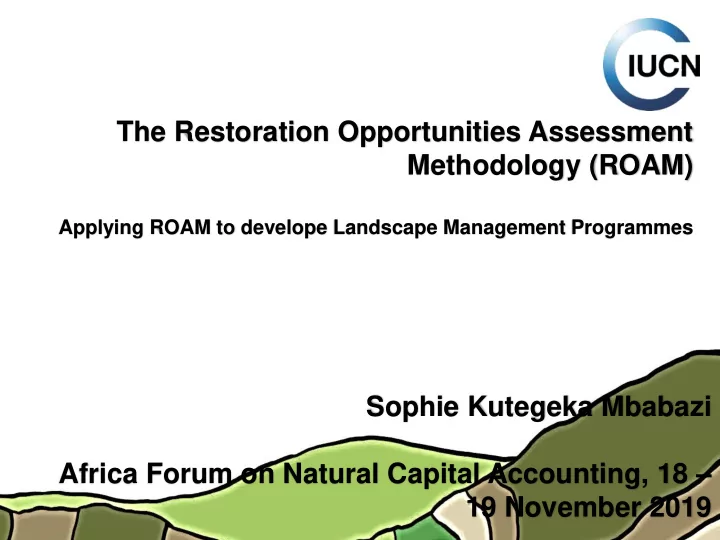

The Restoration Opportunities Assessment Methodology (ROAM) Applying ROAM to develope Landscape Management Programmes Sophie Kutegeka Mbabazi Africa Forum on Natural Capital Accounting, 18 – 19 November 2019
Bonn Challenge launched in 2011 A global goal to restore 150 million hectares of degraded and deforested lands by 2020 now extended to 350 million hectares by 2030
Restoration Opportunities Assessment Methodology (ROAM) A framework for assessing national and subnational restoration potential It can help governments and institutions: • Estimate the economics of restoration strategies • Identify priority landscapes • Develop national-level strategies • Provide often-missing data • Build high-level support
Key aspects of ROAM Stepwise, iterative, flexible and adaptable to any region or landscape. Brings people together to identify, negotiate, and implement FLR activities for restoration. Generates data, robust analysis, decision support, tools Demand driven – ownership – capacity development
ROAM helps you answer the following questions 1. Where is restoration socially, economically and ecologically feasible? 2. What is the total extent of restoration opportunities in the region? 3. Which types of restoration are feasible in different parts of the Country? 4. What are the costs and benefits, including carbon storage and ecosystem services, associated with different restoration strategies? 5. What policy, financial and social incentives exist or are needed to support restoration? 6. Who are the stakeholders with whom we need to engage? 7. What options exist to unlock finance for restoration? 8. How can we scale up restoration? Based on best knowledge and best science.
Key Outputs of ROAM A Theory of Change for short-, medium- and long-term landscape restoration • Institutionalized commitments aligned with user-defined goals of forest landscape restoration • Inter-sectoral and inter-ministerial cooperation and collaboration • Multi-scale capacity development • Technical analysis, evaluation and communication of practical restoration information and knowledge • Assessment of degraded land • Priority areas for restoration and appropriate intervention types • Cost-benefit analysis of restoration scenarios • Ecosystem services analysis and optimization • Business models and opportunities • Financing strategies • A clear pathway for addressing the drivers of degradation
Key components of ROAM Drivers of Stakeholder Stocktaking of degradation and mapping and past successes objectives of engagement and challenges FLR FLR Economics, opportunities, ecosystem Social/Cultural priorities and services, and aspects of FLR transitions finance analysis Development of Data collection Stakeholder FLR action plan and spatial ownership and and finance analysis validation strategy
Managing the ROAM Process Coordinating the political components of ROAM Coordinating the technical components of ROAM Completing the technical components of ROAM
Coordinating the technical components of ROAM Institutional Home ROAM Technical Steering Committee composed of relevant government and non-government stakeholders Thematic Working Thematic Working Group Group Thematic Working Thematic Working Group Group Thematic Working Group
Priority areas for Forest landscape restoration 10
Potential acreage for restoration in each landscape No Landscape zonation Acreage of restoration (Ha) 1 Afro-montane 691,161.1 2 Karamoja 1,775,156.2 3 Lake Victoria crescent 394,491.0 4 Northern moist 2,631,314.7 5 South East Lake Kyoga flood plain 393,639.5 6 Southwest rangeland 1,154,340.1 7 Western mid-altitude 103,9519.5 11
Spatial description of landscape Landscape Deforested Restoratio Target Total Protected Area Restoration land (ha) n (ha) CFR within restoration Area outside area (ha) zone (ha) PA (ha) Northern 4,553,045 2,631,314.7 234,656 705,411 1,925,903.7 Moist Karamoja 684,161 1,775,156.2 332,169 1,061,447 713,709.2 Note: there are several Community Wildlife Conservation areas and private wildlife conservation areas operating with supervision from the UWA. 12
Uganda products 13
THANK YOU! 14
Recommend
More recommend